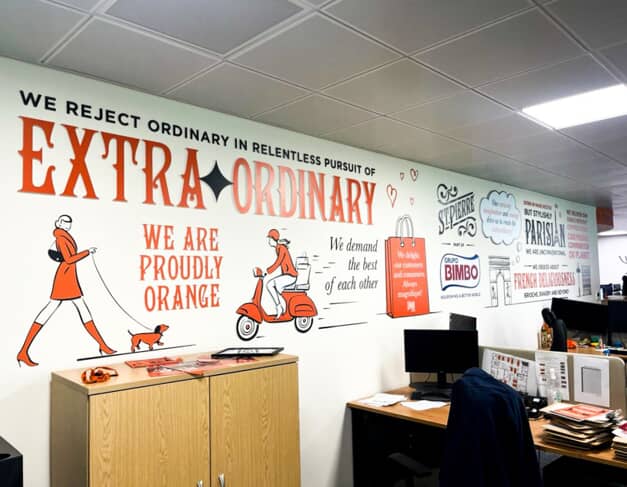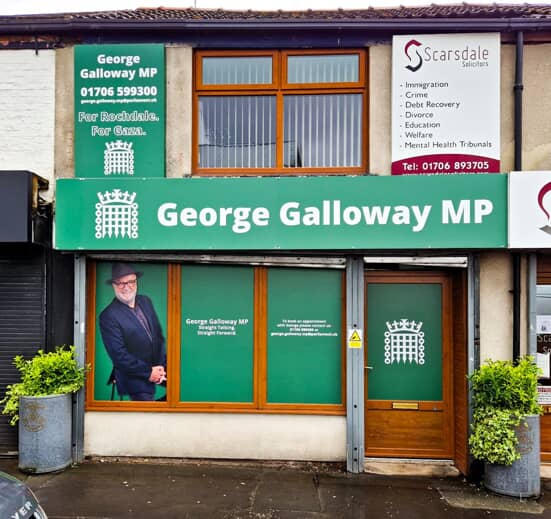We often talk on our Social media channels about how we manufacture our signage. This includes descriptions of the materials we choose to print on for each of our customers’ bespoke signs.

But have you ever wondered why these materials are suitable for contemporary signage requirements? If so, read on!
The first thing to say is that from the traditional to the cutting-edge sign, the selection of the most appropriate material plays a crucial role in a sign’s effectiveness and longevity.
So, let's take a deep dive into the little-known world of signage materials that you’re most likely to see:
The Classics: Enduring Materials for Timeless Displays
Aluminium: This lightweight and versatile metal is a popular choice for a variety of signs. It's resistant to corrosion and weather damage, making it ideal for outdoor applications. Aluminium can be painted in a wide range of colours, making it suitable for creating bold and vibrant signage. Plus, it accepts vinyl graphics well, which will offer particular flexibility and complexity in design.
Composite Materials: These are combinations of different materials, often aluminium sandwiched between plastic layers. These provide the strength and rigidity of aluminium with the lightweight properties and weather resistance of plastic. Composite materials are frequently used for large signs, building fascia -– also known as the front board above a shop window - and even street furniture signs.
Acrylic: This transparent or coloured plastic offers excellent clarity and a high-gloss finish. It's perfect for creating illuminated signs as it allows light to pass through it very effectively. Acrylic is also lightweight and shatter-resistant, making it a good choice for indoor applications where safety might be a particular consideration. Think of Perspex signs on shop doors or clear acrylic displays for product information.

Making an Impact: Materials that Grab Attention
Vinyl: This versatile material is available in a vast array of colours, finishes and textures. It can be printed with high-quality graphics and lettering, making it perfect for creating eye-catching temporary or permanent signage. Vinyl is also relatively inexpensive and can be easily applied to various surfaces.
Dibond: This is a brand name used for a specific type of aluminium composite panel. It's highly valued for its rigidity, flatness and smooth surface. Dibond can be printed directly on or used with vinyl graphics, making it ideal for creating high-impact signage for building exteriors, exhibitions or even temporary displays.
Fabric: While not as common as the previous materials, fabric can be used to create unique and eye-catching signage. Fabric banners are lightweight and portable, making them ideal for events and promotions. They can be printed with vibrant colours and large-scale graphics, making them the perfect choice for grabbing attention at trade shows or outdoor events.
Illuminating the Night: Materials that Shine
Neon: These iconic signs have been synonymous with cityscapes and nightlife for decades. Neon tubes filled with different gasses glow brightly, creating a mesmerizingly impactful effect. While they require more maintenance and they use more energy than LED alternatives, neon signs remain popular for their distinctive look and nostalgic charm. However, concerns about their environmental impact may increasingly limit their use. Perhaps a better solution these days is:
LED (Light Emitting Diode): Modern signage heavily relies on LED technology. LED lights are energy-efficient, long-lasting and available in a wide range of colours and brightness levels. They can be used to create illuminated signs, digital displays, and even dynamic lighting effects. LEDs are in fact increasingly replacing neon because of their lower environmental impact as well as their cost-effectiveness.
Backlit Displays: These signs use LEDs or fluorescent lights to illuminate a panel from behind. This creates a bright and even light distribution, making the message visible even in low-light conditions. Backlit displays are a popular choice for building signage, particularly those with changeable messages like bus stop displays.
Choosing the Right Material: Factors to Consider
Now that you're familiar with some common signage materials, let's explore what factors influence the choice of material for our customers’ individual needs:
Location: Is the sign for indoor or outdoor use? Aluminium and composite materials are weather-resistant, while acrylic and vinyl might be better suited for indoor applications.
Durability: How long do you need the sign to last? Aluminium, Dibond and composite materials offer excellent durability for long-term use. Vinyl and fabric signs may be better used just for temporary applications.
Visibility: Do you need the sign to be visible in low-light conditions? Illuminated signs using LED or neon will ensure your message is clearly seen, even at night.
Budget: Material costs can vary significantly. Consider the trade-off between upfront cost and durability. Vinyl is a cost-effective option, while Dibond or neon signs may require a higher initial investment.
Aesthetics: The material you choose should complement your brand image and overall design. Aluminium offers a sleek and modern look, while wood can create a more rustic and traditional feel. Which one will represent your brand better? Which look will your customers respond more positively towards?

So if you’re needing some signage created or replaced, now you know the basics of the materials that you will be able to use.
Alternatively, you could come talk to us at FASTSIGNS Manchester so we can help you to make the right decision for your business – and of course, we’ll create something really beautiful that impresses your customers in just the right way!